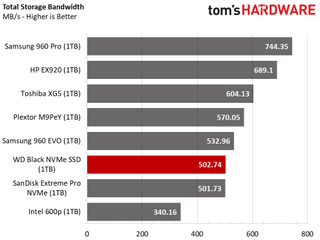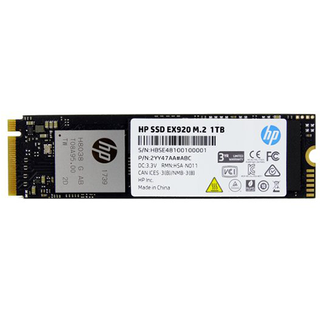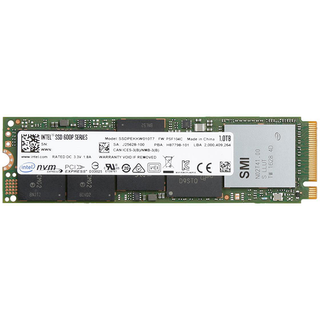WD Black 3D NVMe SSD Review: WD Debuts Its New Controller
Why you can trust Tom's Hardware
1TB Performance Testing
Comparison Products
Our review includes both the WD Black and the nearly-identical SanDisk Extreme Pro. The Extreme Pro may perform slightly better during extended workloads thanks to the metallic sticker, but SanDisk hasn't made that claim.
The 1TB Black carries the same MSRP as the 1TB Samsung 960 EVO, making it clear which competitor Western Digital is targeting with this release. The 1TB 960 EVO joins the 960 Pro, Intel 600p, and Plextor M9Pe in our tests. We also included the Toshiba XG5 that uses the same 64-layer BiCS flash.
The new 1TB HP EX920 review will come in a few weeks, but you can see the test results in this review. This will be one of the most popular NVMe SSDs this summer. It has nearly the same hardware configuration as the Intel SSD 760p that has yet to ship in the 1TB capacity.
Sequential Read Performance
To read about our storage tests in-depth, please check out How We Test HDDs And SSDs. We cover four-corner testing on page six of our How We Test guide.


The WD Black's low queue depth (QD) 2 random read performance stands out. Both the Black and the Extreme Pro experienced the same dip in all three of our test runs. This is likely the result of background activities cleaning cells during our test.
The new WD Black performs well at QD1 with just over 1,500 MB/s of throughput, but we would like to see better QD2 to QD8 performance.
Sequential Write Performance


Compared to other NVMe SSDs, the new nCache 3.0 delivers amazing results during the sequential write workload. The results are among the highest we've ever recorded. The new 1TB Black is even faster than the Samsung 960 Pro.
Random Read Performance



With great highs come great lows. The Black's random read performance isn't very impressive. We recorded just over 10,000 IOPS at QD1 in our burst test. It takes time to leap back to full performance after the PCIe bus transitions from a low power state. Most of the random reads in this test happen during the transition period, which better reflects real-world usage. In contrast, the Black delivered slightly over 12,000 IOPS in our longer test.
Random Write Performance



The new WD controller performs very well with random write data. Many of the NVMe SSDs deliver similar results at low queue depths. We recorded a ~10,000 IOPS delta between the best and worst products at QD1.
70% Mixed Sequential Workload
We describe our mixed workload testing in detail here and describe our steady state tests here.


The dip in QD2 sequential reads doesn't impact performance during the mixed sequential workload. The WD Black chewed through our test at all queue depths. The 1TB drive even topped 3,000 MB/s, but that result came at QD16. That's far above what you will see with most common applications.
70% Mixed Random Workload


The low random read performance played a role in the mixed random workload results. The Black fell to the middle of QD2 test results, which is very close to the Toshiba XG5 and Plextor M9Pe that also use 64-layer BiCS flash.
Sequential Steady-State



The 1TB WD Black and SanDisk Extreme Pro deliver enterprise-class performance after the ten-hour preconditioning period. The duo outperforms the Samsung 960 Pro and nearly double the results of the next best SSD. We didn't expect these great results with TLC flash, but we're happy to see it.
Random Steady-State


The steady-state random write test exposes some variation between the SanDisk Extreme Pro and WD Black. This might be due to the Extreme Pro's metal sticker that dissipates heat from the controller.
The new drives aren't very consistent under these conditions. The low endurance ratings of the new drives will keep data centers from using these SSDs for heavy random write workloads.
PCMark 8 Real-World Software Performance
For details on our real-world software performance testing, please click here.










The early random read results were a precursor of what to expect in the application tests. WD and SanDisk will have to address this area if they want to take the performance crown from Samsung. It's possible to improve random read performance via firmware updates, but we don't know if WD is working on an update to address the issue. For most users, all of the drives in our test will deliver acceptable results and almost indistinguishable performance with common applications (under most conditions).
Application Storage Bandwidth

The new Black and SanDisk Extreme Pro deliver just over 500 MB/s of throughput in our application tests, but we expected more from the high-performance SSDs.
PCMark 8 Advanced Workload Performance
To learn how we test advanced workload performance, please click here.



The new Black trails only the Samsung 960 Pro in this test. The drive is only slightly faster than the Samsung 960 EVO, but it is much faster than the other products in a heavy write environment. Most users will never push these drives this hard during normal use. The recovery results, which have idle time between each pass, are more important.
Total Service Time



You're surrounded by throughput specifications when you go shopping for a new SSD. Throughput is how you measure the speed of a file transfer, but it's not the most common activity. Instead, low latency is what makes our computers feel fast. This metric is representative of the snappiness of your user experience, such as how fast your computer feels as you move between windows and applications. The Black and Extreme Pro deliver the lowest service times throughout the recovery cycles.
Disk Busy Time

Disk busy time is a measurement of how long the drive worked to complete the tasks. This measurement doesn't include system processing time. It's an important measurement because faster time-to-idle results in lower overall power consumption.
The new WD and SanDisk SSDs match the two Samsung SSDs with very low disk busy time during our application workloads.
BAPCo SYSmark 2014 SE Responsiveness Test


The BAPCo SYSmark 2014 SE Responsiveness Test uses actual applications to measure latency instead of traces. We run this test in a Lenovo Y700-17 gaming notebook with the default power settings to mimic normal user activity. The WD Black trails most of the popular NVMe SSDs, including the new HP EX920.
The test also gives us our first look at power consumption. The software measures power at the system level, but it offers enough granularity to show how the storage device can alter overall system power draw.
BAPCo MobileMark 2012.5 Notebook Battery Life
To learn how we test advanced workload performance, please click here.


MobileMark 2012.5 measures notebook battery life. BAPCo designed the test to compare different notebooks, but we repurposed it to compare storage devices by simply swapping out SSDs. This test runs in a Lenovo Y700-17 like the SYSmark test, but we remove the AC power. The gaming notebook isn't designed for all-day battery life, but it still provides roughly five hours of use while running a typical office workload.
The WD Black delivered 317 minutes of battery life in our gaming notebook. The result isn't great, but it's far from the worst we've recorded. The performance score came to 1705 with the system running in the low power states that reduce CPU, DRAM and PCIe speeds. The Samsung 960 Pro is the only SSD that performed better.
MORE: Best SSDs
MORE: How We Test HDDs And SSDs
MORE: All SSD Content
Stay on the Cutting Edge
Join the experts who read Tom's Hardware for the inside track on enthusiast PC tech news — and have for over 25 years. We'll send breaking news and in-depth reviews of CPUs, GPUs, AI, maker hardware and more straight to your inbox.
-
Snipergod87 What does "The 960 EVO uses a five-core ARM design for the 960 Pro and various enterprise variants." mean on page 1Reply -
AgentLozen ReplySniperGod87 said:What does "The 960 EVO uses a five-core ARM design for the 960 Pro and various enterprise variants." mean on page 1
It sounds like the controller that powers both the 960 EVO and the 960 Pro is built on a five-core ARM architecture. Also, Samsung has enterprise level solid state drives built on the same controller.
edit: In retrospect, I'm not sure if I interpreted your question correctly. -
photonboy "The 960 EVO uses a five-core ARM design for the 960 Pro and various enterprise variants."Reply
I guess that's been changed to this:
"WD chose a 28nm tri-core design to target the same market Samsung addresses with the 960 EVO. Samsung uses a five-core ARM design for the 960 Pro and various enterprise variants." -
Ninjawithagun Your benchmarks are wrong. I own a Samsung EVO 960 and am using the latest firmware as well as the most current Samsung NVMe driver for Windows 10. My EVO 960 easily beats the WD Black NVMe in every single benchmark you ran. Something tells me that you did not update your test hardware properly.Reply -
CRamseyer The 960 EVO was updated and retested on December 9th, 2017 for the new burst test results. The results are accurate for the tests. If you use CrystalDisk Mark then your test parameters are different than mine.Reply -
2Be_or_Not2Be Can it be explained how the Toshiba was #1 in the 70% Mixed Sequential Workload when it finished mid to low in every other test, including the sequential read/write tests?Reply -
silver12 In other SSDs reviews you showed the HD Tune Pro test for sequential write. I find that information very interesting. Is there a chance you can add that test?Reply
Thank you very much -
mischon123 Good review. So its basically a broken design with flawed firmware that cannot outperform a 6 year old Samsung product and WD cannot fix the flaws themselves and it took an external firm to tame some of the bugs in the sd design. Now your supposed to pay the same price as you would for a fully working Samsung SSD? Yeahhh, riiiighhht.Reply -
CRamseyer The cache on the 1TB drive is right around 20GB with 128KB blocks. In the future we will publish that data in a line chart. I'm just working on getting a few products retested.Reply -
Geef Does WD use write cache like the Samsung EVO does? Once the cache is used the performance drops off. The Samsung PRO doesn't use cache, its just faster overall. Its a big reason the price difference between the two.Reply



